Analysis of Starbucks Operations Management and Leadership Approaches
VerifiedAdded on 2021/02/20
|13
|4177
|448
Report
AI Summary
This report provides an in-depth analysis of Starbucks' operations and management practices. It begins with an introduction to operations management and then delves into the roles of leaders and managers in various organizational situations, such as addressing poor productivity, employee turnover, interpersonal conflicts, and achieving stretch goals. The report then explores different leadership theories, including situational, systems, and contingency leadership, and how these theories are applied within Starbucks. Furthermore, it examines key approaches to operations management, such as Total Quality Management (TQM), Just-in-Time (JIT), and the Kaizen approach, detailing the roles of managers and leaders in implementing these strategies. The report emphasizes the importance and value of operations management in controlling distribution systems and enhancing overall efficiency and productivity within Starbucks. Finally, it assesses the factors within the business environment that impact operational management and decision-making processes for leaders and managers. The report concludes with a summary of the key findings and insights into Starbucks' operational strategies.
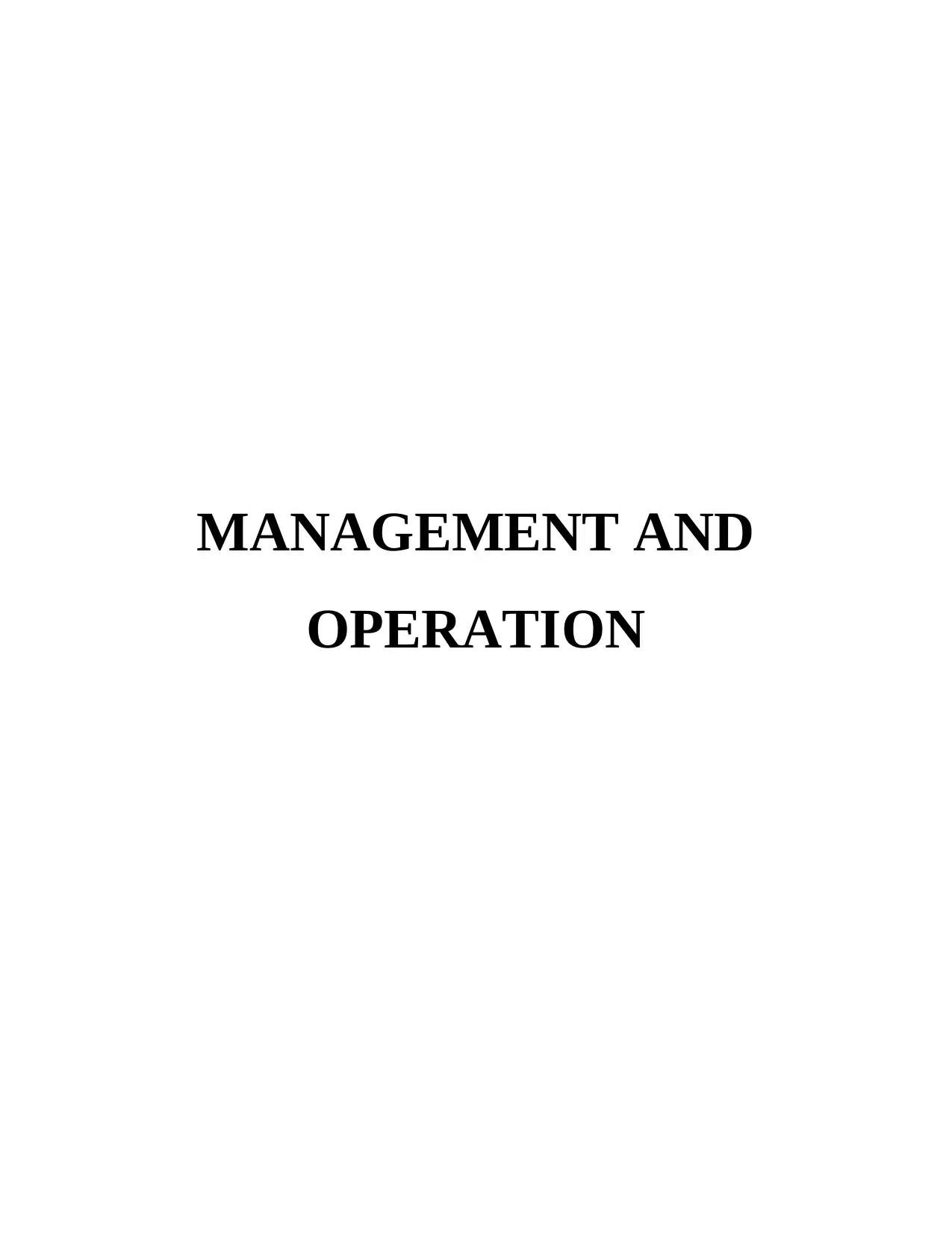
MANAGEMENT AND
OPERATION
OPERATION
Paraphrase This Document
Need a fresh take? Get an instant paraphrase of this document with our AI Paraphraser
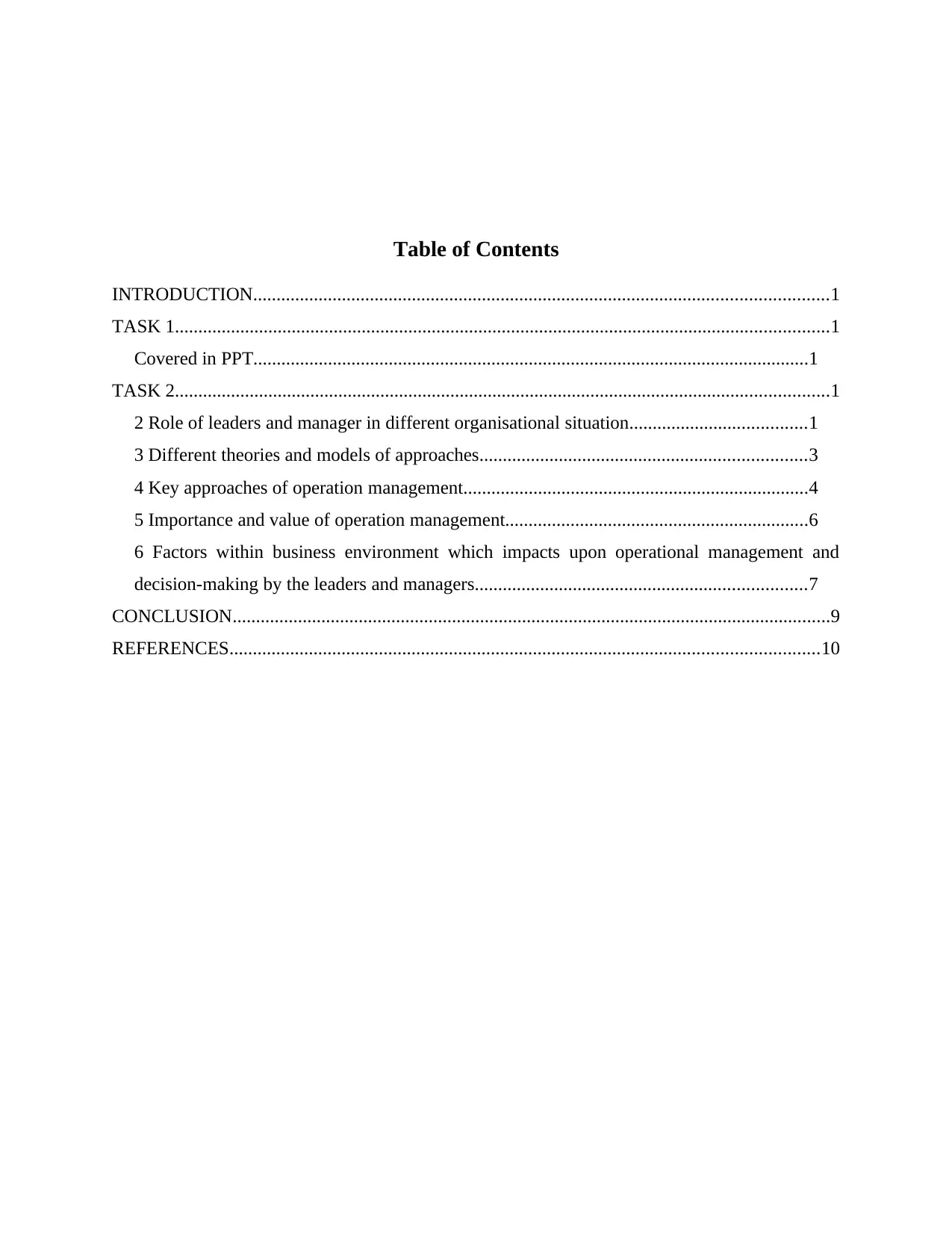
Table of Contents
INTRODUCTION...........................................................................................................................1
TASK 1............................................................................................................................................1
Covered in PPT.......................................................................................................................1
TASK 2............................................................................................................................................1
2 Role of leaders and manager in different organisational situation......................................1
3 Different theories and models of approaches......................................................................3
4 Key approaches of operation management..........................................................................4
5 Importance and value of operation management.................................................................6
6 Factors within business environment which impacts upon operational management and
decision-making by the leaders and managers.......................................................................7
CONCLUSION................................................................................................................................9
REFERENCES..............................................................................................................................10
INTRODUCTION...........................................................................................................................1
TASK 1............................................................................................................................................1
Covered in PPT.......................................................................................................................1
TASK 2............................................................................................................................................1
2 Role of leaders and manager in different organisational situation......................................1
3 Different theories and models of approaches......................................................................3
4 Key approaches of operation management..........................................................................4
5 Importance and value of operation management.................................................................6
6 Factors within business environment which impacts upon operational management and
decision-making by the leaders and managers.......................................................................7
CONCLUSION................................................................................................................................9
REFERENCES..............................................................................................................................10
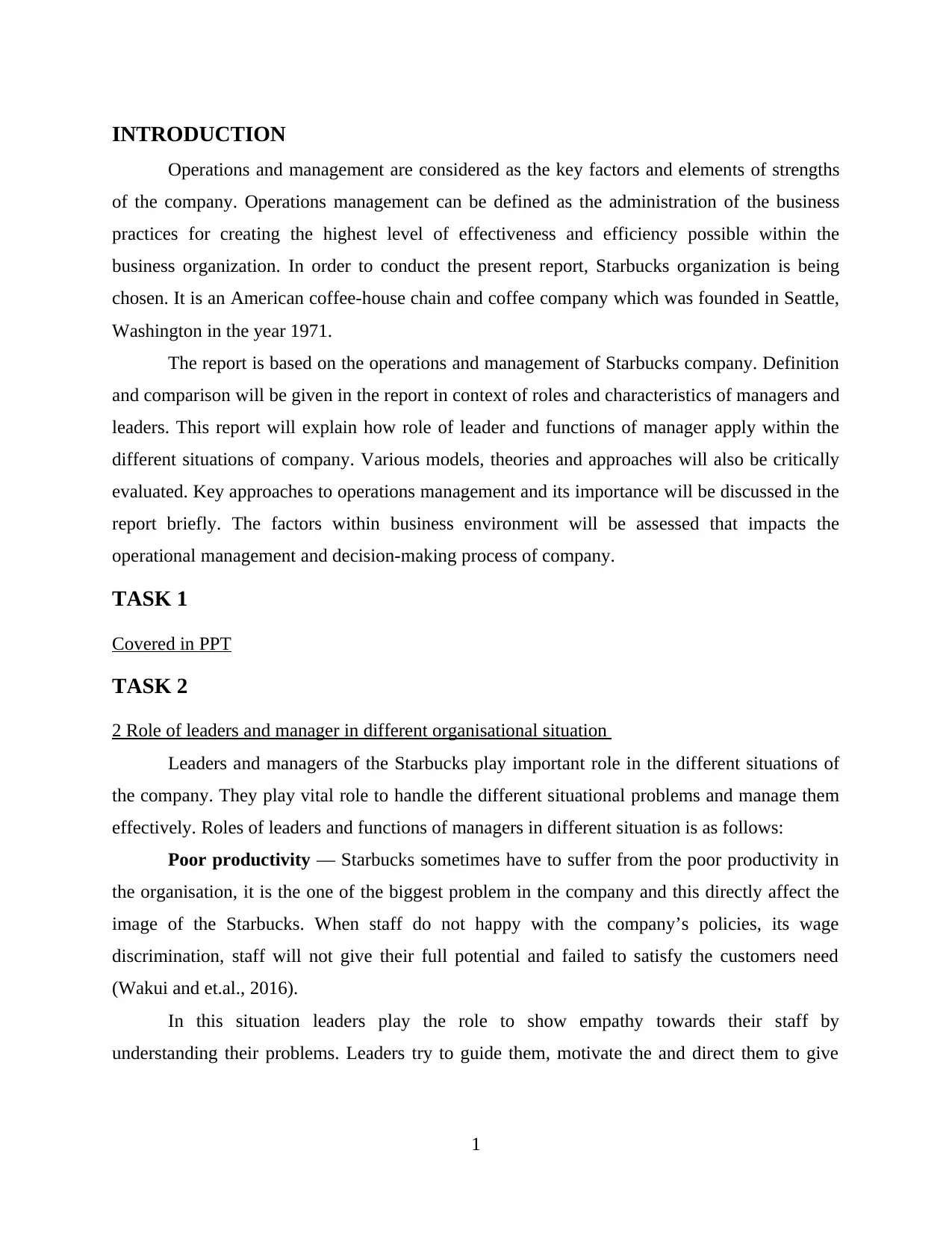
INTRODUCTION
Operations and management are considered as the key factors and elements of strengths
of the company. Operations management can be defined as the administration of the business
practices for creating the highest level of effectiveness and efficiency possible within the
business organization. In order to conduct the present report, Starbucks organization is being
chosen. It is an American coffee-house chain and coffee company which was founded in Seattle,
Washington in the year 1971.
The report is based on the operations and management of Starbucks company. Definition
and comparison will be given in the report in context of roles and characteristics of managers and
leaders. This report will explain how role of leader and functions of manager apply within the
different situations of company. Various models, theories and approaches will also be critically
evaluated. Key approaches to operations management and its importance will be discussed in the
report briefly. The factors within business environment will be assessed that impacts the
operational management and decision-making process of company.
TASK 1
Covered in PPT
TASK 2
2 Role of leaders and manager in different organisational situation
Leaders and managers of the Starbucks play important role in the different situations of
the company. They play vital role to handle the different situational problems and manage them
effectively. Roles of leaders and functions of managers in different situation is as follows:
Poor productivity — Starbucks sometimes have to suffer from the poor productivity in
the organisation, it is the one of the biggest problem in the company and this directly affect the
image of the Starbucks. When staff do not happy with the company’s policies, its wage
discrimination, staff will not give their full potential and failed to satisfy the customers need
(Wakui and et.al., 2016).
In this situation leaders play the role to show empathy towards their staff by
understanding their problems. Leaders try to guide them, motivate the and direct them to give
1
Operations and management are considered as the key factors and elements of strengths
of the company. Operations management can be defined as the administration of the business
practices for creating the highest level of effectiveness and efficiency possible within the
business organization. In order to conduct the present report, Starbucks organization is being
chosen. It is an American coffee-house chain and coffee company which was founded in Seattle,
Washington in the year 1971.
The report is based on the operations and management of Starbucks company. Definition
and comparison will be given in the report in context of roles and characteristics of managers and
leaders. This report will explain how role of leader and functions of manager apply within the
different situations of company. Various models, theories and approaches will also be critically
evaluated. Key approaches to operations management and its importance will be discussed in the
report briefly. The factors within business environment will be assessed that impacts the
operational management and decision-making process of company.
TASK 1
Covered in PPT
TASK 2
2 Role of leaders and manager in different organisational situation
Leaders and managers of the Starbucks play important role in the different situations of
the company. They play vital role to handle the different situational problems and manage them
effectively. Roles of leaders and functions of managers in different situation is as follows:
Poor productivity — Starbucks sometimes have to suffer from the poor productivity in
the organisation, it is the one of the biggest problem in the company and this directly affect the
image of the Starbucks. When staff do not happy with the company’s policies, its wage
discrimination, staff will not give their full potential and failed to satisfy the customers need
(Wakui and et.al., 2016).
In this situation leaders play the role to show empathy towards their staff by
understanding their problems. Leaders try to guide them, motivate the and direct them to give
1
⊘ This is a preview!⊘
Do you want full access?
Subscribe today to unlock all pages.

Trusted by 1+ million students worldwide
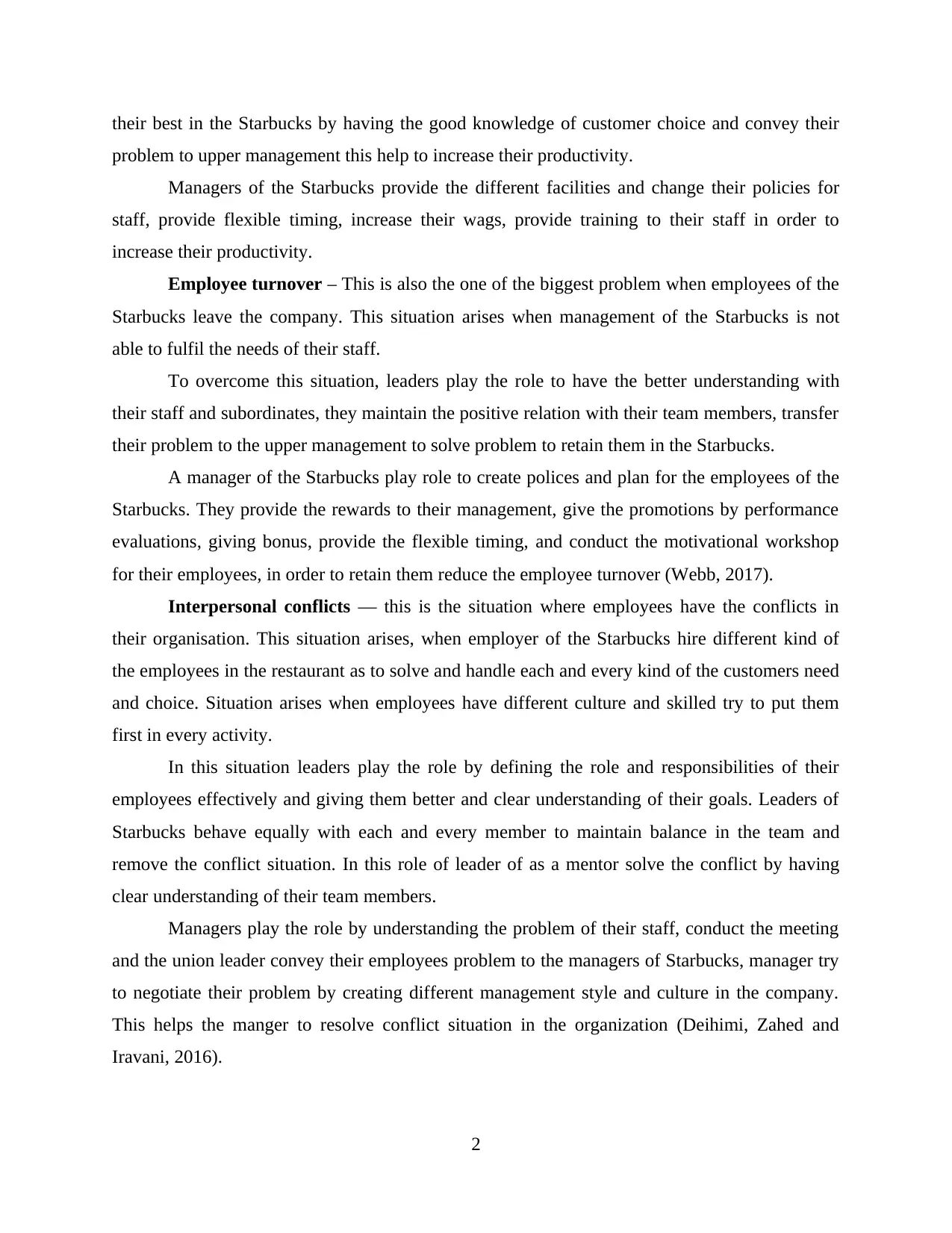
their best in the Starbucks by having the good knowledge of customer choice and convey their
problem to upper management this help to increase their productivity.
Managers of the Starbucks provide the different facilities and change their policies for
staff, provide flexible timing, increase their wags, provide training to their staff in order to
increase their productivity.
Employee turnover – This is also the one of the biggest problem when employees of the
Starbucks leave the company. This situation arises when management of the Starbucks is not
able to fulfil the needs of their staff.
To overcome this situation, leaders play the role to have the better understanding with
their staff and subordinates, they maintain the positive relation with their team members, transfer
their problem to the upper management to solve problem to retain them in the Starbucks.
A manager of the Starbucks play role to create polices and plan for the employees of the
Starbucks. They provide the rewards to their management, give the promotions by performance
evaluations, giving bonus, provide the flexible timing, and conduct the motivational workshop
for their employees, in order to retain them reduce the employee turnover (Webb, 2017).
Interpersonal conflicts — this is the situation where employees have the conflicts in
their organisation. This situation arises, when employer of the Starbucks hire different kind of
the employees in the restaurant as to solve and handle each and every kind of the customers need
and choice. Situation arises when employees have different culture and skilled try to put them
first in every activity.
In this situation leaders play the role by defining the role and responsibilities of their
employees effectively and giving them better and clear understanding of their goals. Leaders of
Starbucks behave equally with each and every member to maintain balance in the team and
remove the conflict situation. In this role of leader of as a mentor solve the conflict by having
clear understanding of their team members.
Managers play the role by understanding the problem of their staff, conduct the meeting
and the union leader convey their employees problem to the managers of Starbucks, manager try
to negotiate their problem by creating different management style and culture in the company.
This helps the manger to resolve conflict situation in the organization (Deihimi, Zahed and
Iravani, 2016).
2
problem to upper management this help to increase their productivity.
Managers of the Starbucks provide the different facilities and change their policies for
staff, provide flexible timing, increase their wags, provide training to their staff in order to
increase their productivity.
Employee turnover – This is also the one of the biggest problem when employees of the
Starbucks leave the company. This situation arises when management of the Starbucks is not
able to fulfil the needs of their staff.
To overcome this situation, leaders play the role to have the better understanding with
their staff and subordinates, they maintain the positive relation with their team members, transfer
their problem to the upper management to solve problem to retain them in the Starbucks.
A manager of the Starbucks play role to create polices and plan for the employees of the
Starbucks. They provide the rewards to their management, give the promotions by performance
evaluations, giving bonus, provide the flexible timing, and conduct the motivational workshop
for their employees, in order to retain them reduce the employee turnover (Webb, 2017).
Interpersonal conflicts — this is the situation where employees have the conflicts in
their organisation. This situation arises, when employer of the Starbucks hire different kind of
the employees in the restaurant as to solve and handle each and every kind of the customers need
and choice. Situation arises when employees have different culture and skilled try to put them
first in every activity.
In this situation leaders play the role by defining the role and responsibilities of their
employees effectively and giving them better and clear understanding of their goals. Leaders of
Starbucks behave equally with each and every member to maintain balance in the team and
remove the conflict situation. In this role of leader of as a mentor solve the conflict by having
clear understanding of their team members.
Managers play the role by understanding the problem of their staff, conduct the meeting
and the union leader convey their employees problem to the managers of Starbucks, manager try
to negotiate their problem by creating different management style and culture in the company.
This helps the manger to resolve conflict situation in the organization (Deihimi, Zahed and
Iravani, 2016).
2
Paraphrase This Document
Need a fresh take? Get an instant paraphrase of this document with our AI Paraphraser
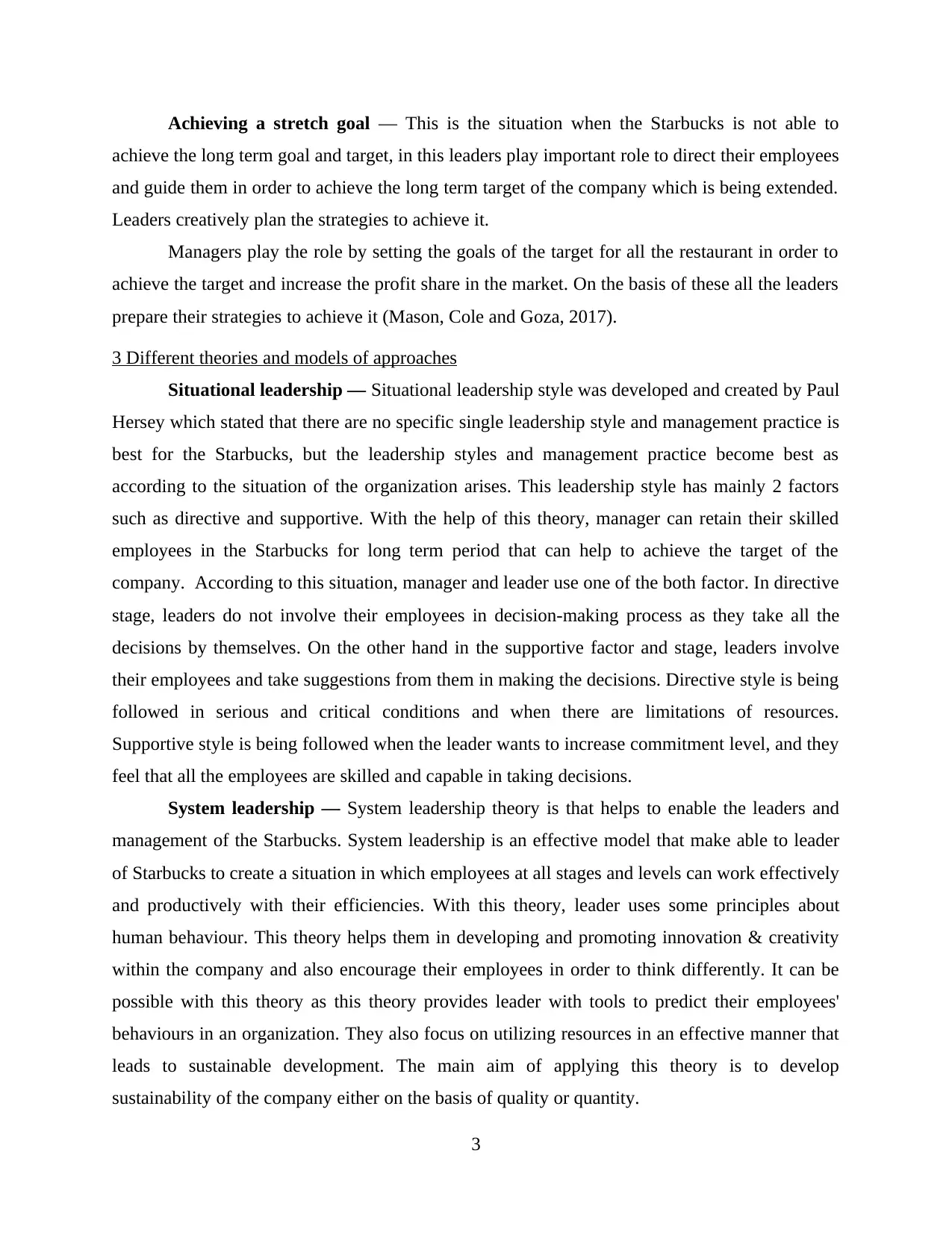
Achieving a stretch goal — This is the situation when the Starbucks is not able to
achieve the long term goal and target, in this leaders play important role to direct their employees
and guide them in order to achieve the long term target of the company which is being extended.
Leaders creatively plan the strategies to achieve it.
Managers play the role by setting the goals of the target for all the restaurant in order to
achieve the target and increase the profit share in the market. On the basis of these all the leaders
prepare their strategies to achieve it (Mason, Cole and Goza, 2017).
3 Different theories and models of approaches
Situational leadership — Situational leadership style was developed and created by Paul
Hersey which stated that there are no specific single leadership style and management practice is
best for the Starbucks, but the leadership styles and management practice become best as
according to the situation of the organization arises. This leadership style has mainly 2 factors
such as directive and supportive. With the help of this theory, manager can retain their skilled
employees in the Starbucks for long term period that can help to achieve the target of the
company. According to this situation, manager and leader use one of the both factor. In directive
stage, leaders do not involve their employees in decision-making process as they take all the
decisions by themselves. On the other hand in the supportive factor and stage, leaders involve
their employees and take suggestions from them in making the decisions. Directive style is being
followed in serious and critical conditions and when there are limitations of resources.
Supportive style is being followed when the leader wants to increase commitment level, and they
feel that all the employees are skilled and capable in taking decisions.
System leadership — System leadership theory is that helps to enable the leaders and
management of the Starbucks. System leadership is an effective model that make able to leader
of Starbucks to create a situation in which employees at all stages and levels can work effectively
and productively with their efficiencies. With this theory, leader uses some principles about
human behaviour. This theory helps them in developing and promoting innovation & creativity
within the company and also encourage their employees in order to think differently. It can be
possible with this theory as this theory provides leader with tools to predict their employees'
behaviours in an organization. They also focus on utilizing resources in an effective manner that
leads to sustainable development. The main aim of applying this theory is to develop
sustainability of the company either on the basis of quality or quantity.
3
achieve the long term goal and target, in this leaders play important role to direct their employees
and guide them in order to achieve the long term target of the company which is being extended.
Leaders creatively plan the strategies to achieve it.
Managers play the role by setting the goals of the target for all the restaurant in order to
achieve the target and increase the profit share in the market. On the basis of these all the leaders
prepare their strategies to achieve it (Mason, Cole and Goza, 2017).
3 Different theories and models of approaches
Situational leadership — Situational leadership style was developed and created by Paul
Hersey which stated that there are no specific single leadership style and management practice is
best for the Starbucks, but the leadership styles and management practice become best as
according to the situation of the organization arises. This leadership style has mainly 2 factors
such as directive and supportive. With the help of this theory, manager can retain their skilled
employees in the Starbucks for long term period that can help to achieve the target of the
company. According to this situation, manager and leader use one of the both factor. In directive
stage, leaders do not involve their employees in decision-making process as they take all the
decisions by themselves. On the other hand in the supportive factor and stage, leaders involve
their employees and take suggestions from them in making the decisions. Directive style is being
followed in serious and critical conditions and when there are limitations of resources.
Supportive style is being followed when the leader wants to increase commitment level, and they
feel that all the employees are skilled and capable in taking decisions.
System leadership — System leadership theory is that helps to enable the leaders and
management of the Starbucks. System leadership is an effective model that make able to leader
of Starbucks to create a situation in which employees at all stages and levels can work effectively
and productively with their efficiencies. With this theory, leader uses some principles about
human behaviour. This theory helps them in developing and promoting innovation & creativity
within the company and also encourage their employees in order to think differently. It can be
possible with this theory as this theory provides leader with tools to predict their employees'
behaviours in an organization. They also focus on utilizing resources in an effective manner that
leads to sustainable development. The main aim of applying this theory is to develop
sustainability of the company either on the basis of quality or quantity.
3
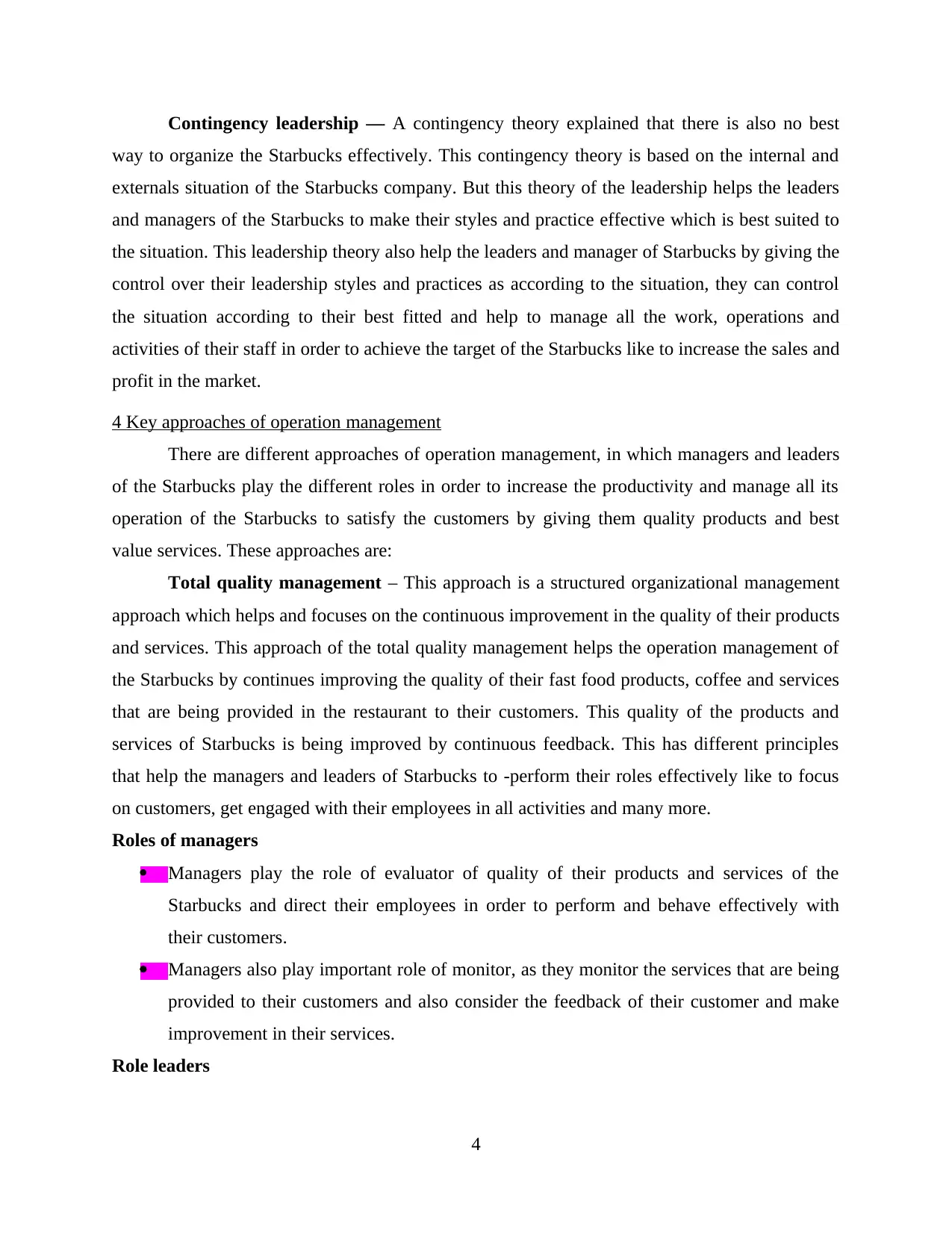
Contingency leadership — A contingency theory explained that there is also no best
way to organize the Starbucks effectively. This contingency theory is based on the internal and
externals situation of the Starbucks company. But this theory of the leadership helps the leaders
and managers of the Starbucks to make their styles and practice effective which is best suited to
the situation. This leadership theory also help the leaders and manager of Starbucks by giving the
control over their leadership styles and practices as according to the situation, they can control
the situation according to their best fitted and help to manage all the work, operations and
activities of their staff in order to achieve the target of the Starbucks like to increase the sales and
profit in the market.
4 Key approaches of operation management
There are different approaches of operation management, in which managers and leaders
of the Starbucks play the different roles in order to increase the productivity and manage all its
operation of the Starbucks to satisfy the customers by giving them quality products and best
value services. These approaches are:
Total quality management – This approach is a structured organizational management
approach which helps and focuses on the continuous improvement in the quality of their products
and services. This approach of the total quality management helps the operation management of
the Starbucks by continues improving the quality of their fast food products, coffee and services
that are being provided in the restaurant to their customers. This quality of the products and
services of Starbucks is being improved by continuous feedback. This has different principles
that help the managers and leaders of Starbucks to -perform their roles effectively like to focus
on customers, get engaged with their employees in all activities and many more.
Roles of managers
Managers play the role of evaluator of quality of their products and services of the
Starbucks and direct their employees in order to perform and behave effectively with
their customers.
Managers also play important role of monitor, as they monitor the services that are being
provided to their customers and also consider the feedback of their customer and make
improvement in their services.
Role leaders
4
way to organize the Starbucks effectively. This contingency theory is based on the internal and
externals situation of the Starbucks company. But this theory of the leadership helps the leaders
and managers of the Starbucks to make their styles and practice effective which is best suited to
the situation. This leadership theory also help the leaders and manager of Starbucks by giving the
control over their leadership styles and practices as according to the situation, they can control
the situation according to their best fitted and help to manage all the work, operations and
activities of their staff in order to achieve the target of the Starbucks like to increase the sales and
profit in the market.
4 Key approaches of operation management
There are different approaches of operation management, in which managers and leaders
of the Starbucks play the different roles in order to increase the productivity and manage all its
operation of the Starbucks to satisfy the customers by giving them quality products and best
value services. These approaches are:
Total quality management – This approach is a structured organizational management
approach which helps and focuses on the continuous improvement in the quality of their products
and services. This approach of the total quality management helps the operation management of
the Starbucks by continues improving the quality of their fast food products, coffee and services
that are being provided in the restaurant to their customers. This quality of the products and
services of Starbucks is being improved by continuous feedback. This has different principles
that help the managers and leaders of Starbucks to -perform their roles effectively like to focus
on customers, get engaged with their employees in all activities and many more.
Roles of managers
Managers play the role of evaluator of quality of their products and services of the
Starbucks and direct their employees in order to perform and behave effectively with
their customers.
Managers also play important role of monitor, as they monitor the services that are being
provided to their customers and also consider the feedback of their customer and make
improvement in their services.
Role leaders
4
⊘ This is a preview!⊘
Do you want full access?
Subscribe today to unlock all pages.

Trusted by 1+ million students worldwide
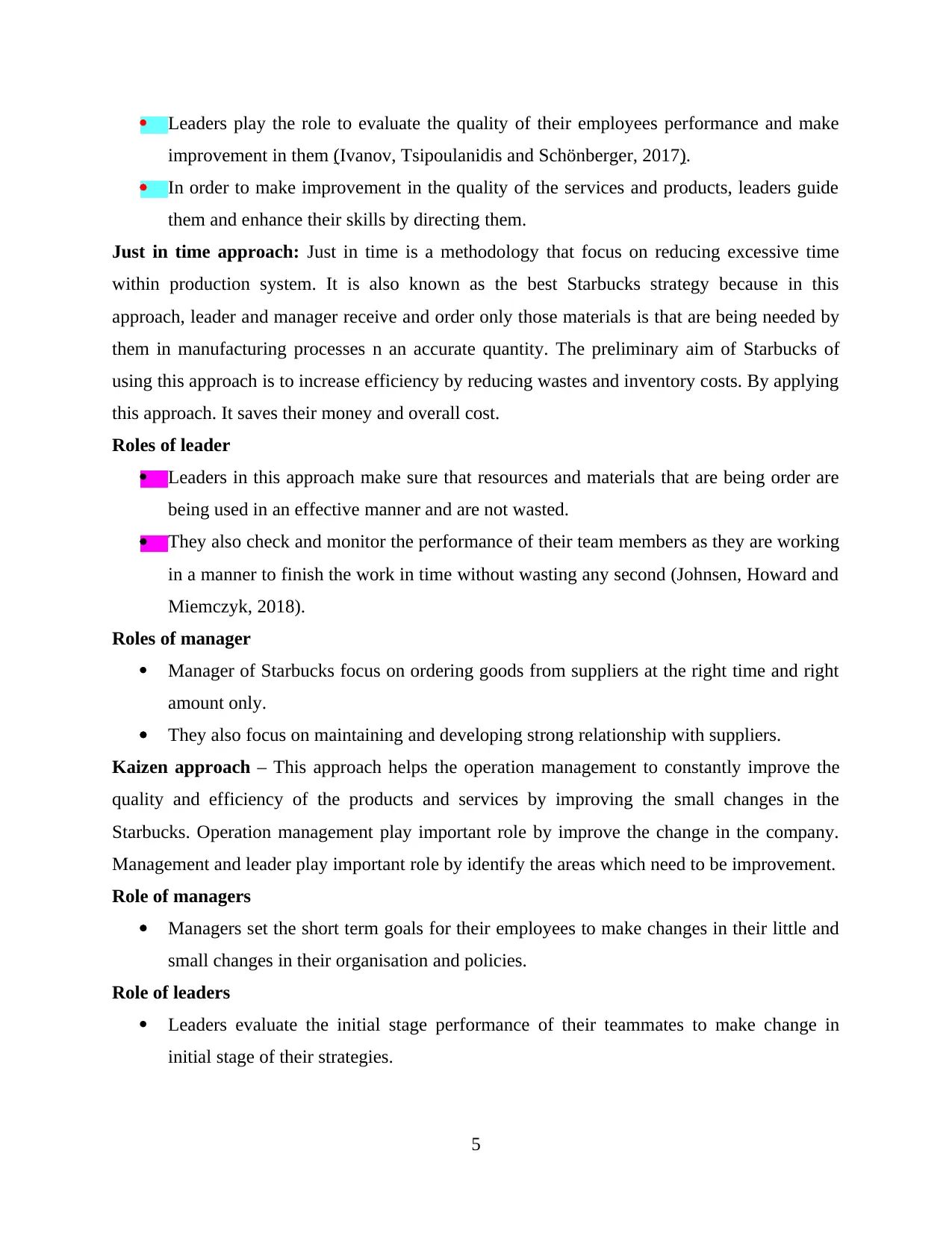
Leaders play the role to evaluate the quality of their employees performance and make
improvement in them (Ivanov, Tsipoulanidis and Schönberger, 2017).
In order to make improvement in the quality of the services and products, leaders guide
them and enhance their skills by directing them.
Just in time approach: Just in time is a methodology that focus on reducing excessive time
within production system. It is also known as the best Starbucks strategy because in this
approach, leader and manager receive and order only those materials is that are being needed by
them in manufacturing processes n an accurate quantity. The preliminary aim of Starbucks of
using this approach is to increase efficiency by reducing wastes and inventory costs. By applying
this approach. It saves their money and overall cost.
Roles of leader
Leaders in this approach make sure that resources and materials that are being order are
being used in an effective manner and are not wasted.
They also check and monitor the performance of their team members as they are working
in a manner to finish the work in time without wasting any second (Johnsen, Howard and
Miemczyk, 2018).
Roles of manager
Manager of Starbucks focus on ordering goods from suppliers at the right time and right
amount only.
They also focus on maintaining and developing strong relationship with suppliers.
Kaizen approach – This approach helps the operation management to constantly improve the
quality and efficiency of the products and services by improving the small changes in the
Starbucks. Operation management play important role by improve the change in the company.
Management and leader play important role by identify the areas which need to be improvement.
Role of managers
Managers set the short term goals for their employees to make changes in their little and
small changes in their organisation and policies.
Role of leaders
Leaders evaluate the initial stage performance of their teammates to make change in
initial stage of their strategies.
5
improvement in them (Ivanov, Tsipoulanidis and Schönberger, 2017).
In order to make improvement in the quality of the services and products, leaders guide
them and enhance their skills by directing them.
Just in time approach: Just in time is a methodology that focus on reducing excessive time
within production system. It is also known as the best Starbucks strategy because in this
approach, leader and manager receive and order only those materials is that are being needed by
them in manufacturing processes n an accurate quantity. The preliminary aim of Starbucks of
using this approach is to increase efficiency by reducing wastes and inventory costs. By applying
this approach. It saves their money and overall cost.
Roles of leader
Leaders in this approach make sure that resources and materials that are being order are
being used in an effective manner and are not wasted.
They also check and monitor the performance of their team members as they are working
in a manner to finish the work in time without wasting any second (Johnsen, Howard and
Miemczyk, 2018).
Roles of manager
Manager of Starbucks focus on ordering goods from suppliers at the right time and right
amount only.
They also focus on maintaining and developing strong relationship with suppliers.
Kaizen approach – This approach helps the operation management to constantly improve the
quality and efficiency of the products and services by improving the small changes in the
Starbucks. Operation management play important role by improve the change in the company.
Management and leader play important role by identify the areas which need to be improvement.
Role of managers
Managers set the short term goals for their employees to make changes in their little and
small changes in their organisation and policies.
Role of leaders
Leaders evaluate the initial stage performance of their teammates to make change in
initial stage of their strategies.
5
Paraphrase This Document
Need a fresh take? Get an instant paraphrase of this document with our AI Paraphraser
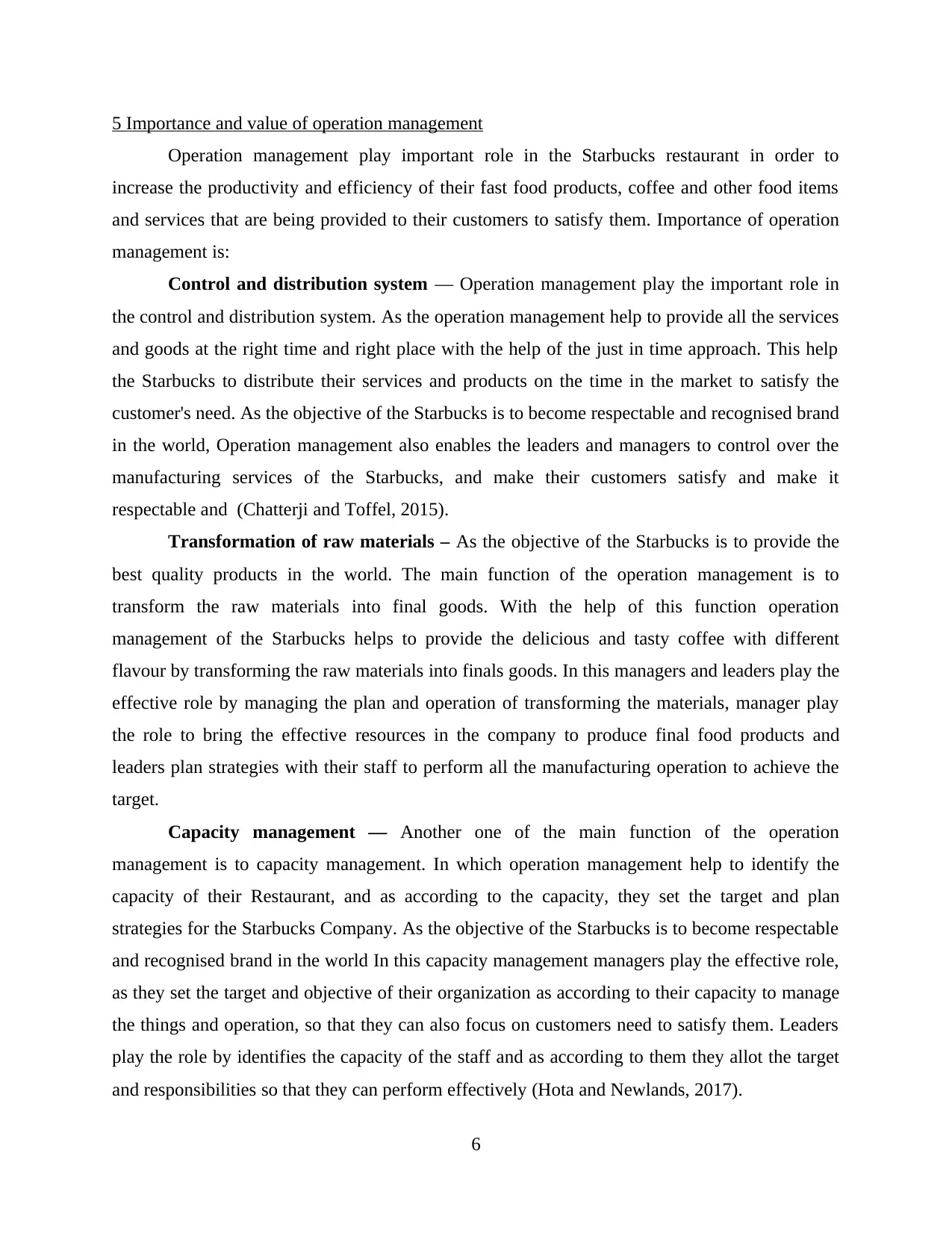
5 Importance and value of operation management
Operation management play important role in the Starbucks restaurant in order to
increase the productivity and efficiency of their fast food products, coffee and other food items
and services that are being provided to their customers to satisfy them. Importance of operation
management is:
Control and distribution system — Operation management play the important role in
the control and distribution system. As the operation management help to provide all the services
and goods at the right time and right place with the help of the just in time approach. This help
the Starbucks to distribute their services and products on the time in the market to satisfy the
customer's need. As the objective of the Starbucks is to become respectable and recognised brand
in the world, Operation management also enables the leaders and managers to control over the
manufacturing services of the Starbucks, and make their customers satisfy and make it
respectable and (Chatterji and Toffel, 2015).
Transformation of raw materials – As the objective of the Starbucks is to provide the
best quality products in the world. The main function of the operation management is to
transform the raw materials into final goods. With the help of this function operation
management of the Starbucks helps to provide the delicious and tasty coffee with different
flavour by transforming the raw materials into finals goods. In this managers and leaders play the
effective role by managing the plan and operation of transforming the materials, manager play
the role to bring the effective resources in the company to produce final food products and
leaders plan strategies with their staff to perform all the manufacturing operation to achieve the
target.
Capacity management — Another one of the main function of the operation
management is to capacity management. In which operation management help to identify the
capacity of their Restaurant, and as according to the capacity, they set the target and plan
strategies for the Starbucks Company. As the objective of the Starbucks is to become respectable
and recognised brand in the world In this capacity management managers play the effective role,
as they set the target and objective of their organization as according to their capacity to manage
the things and operation, so that they can also focus on customers need to satisfy them. Leaders
play the role by identifies the capacity of the staff and as according to them they allot the target
and responsibilities so that they can perform effectively (Hota and Newlands, 2017).
6
Operation management play important role in the Starbucks restaurant in order to
increase the productivity and efficiency of their fast food products, coffee and other food items
and services that are being provided to their customers to satisfy them. Importance of operation
management is:
Control and distribution system — Operation management play the important role in
the control and distribution system. As the operation management help to provide all the services
and goods at the right time and right place with the help of the just in time approach. This help
the Starbucks to distribute their services and products on the time in the market to satisfy the
customer's need. As the objective of the Starbucks is to become respectable and recognised brand
in the world, Operation management also enables the leaders and managers to control over the
manufacturing services of the Starbucks, and make their customers satisfy and make it
respectable and (Chatterji and Toffel, 2015).
Transformation of raw materials – As the objective of the Starbucks is to provide the
best quality products in the world. The main function of the operation management is to
transform the raw materials into final goods. With the help of this function operation
management of the Starbucks helps to provide the delicious and tasty coffee with different
flavour by transforming the raw materials into finals goods. In this managers and leaders play the
effective role by managing the plan and operation of transforming the materials, manager play
the role to bring the effective resources in the company to produce final food products and
leaders plan strategies with their staff to perform all the manufacturing operation to achieve the
target.
Capacity management — Another one of the main function of the operation
management is to capacity management. In which operation management help to identify the
capacity of their Restaurant, and as according to the capacity, they set the target and plan
strategies for the Starbucks Company. As the objective of the Starbucks is to become respectable
and recognised brand in the world In this capacity management managers play the effective role,
as they set the target and objective of their organization as according to their capacity to manage
the things and operation, so that they can also focus on customers need to satisfy them. Leaders
play the role by identifies the capacity of the staff and as according to them they allot the target
and responsibilities so that they can perform effectively (Hota and Newlands, 2017).
6
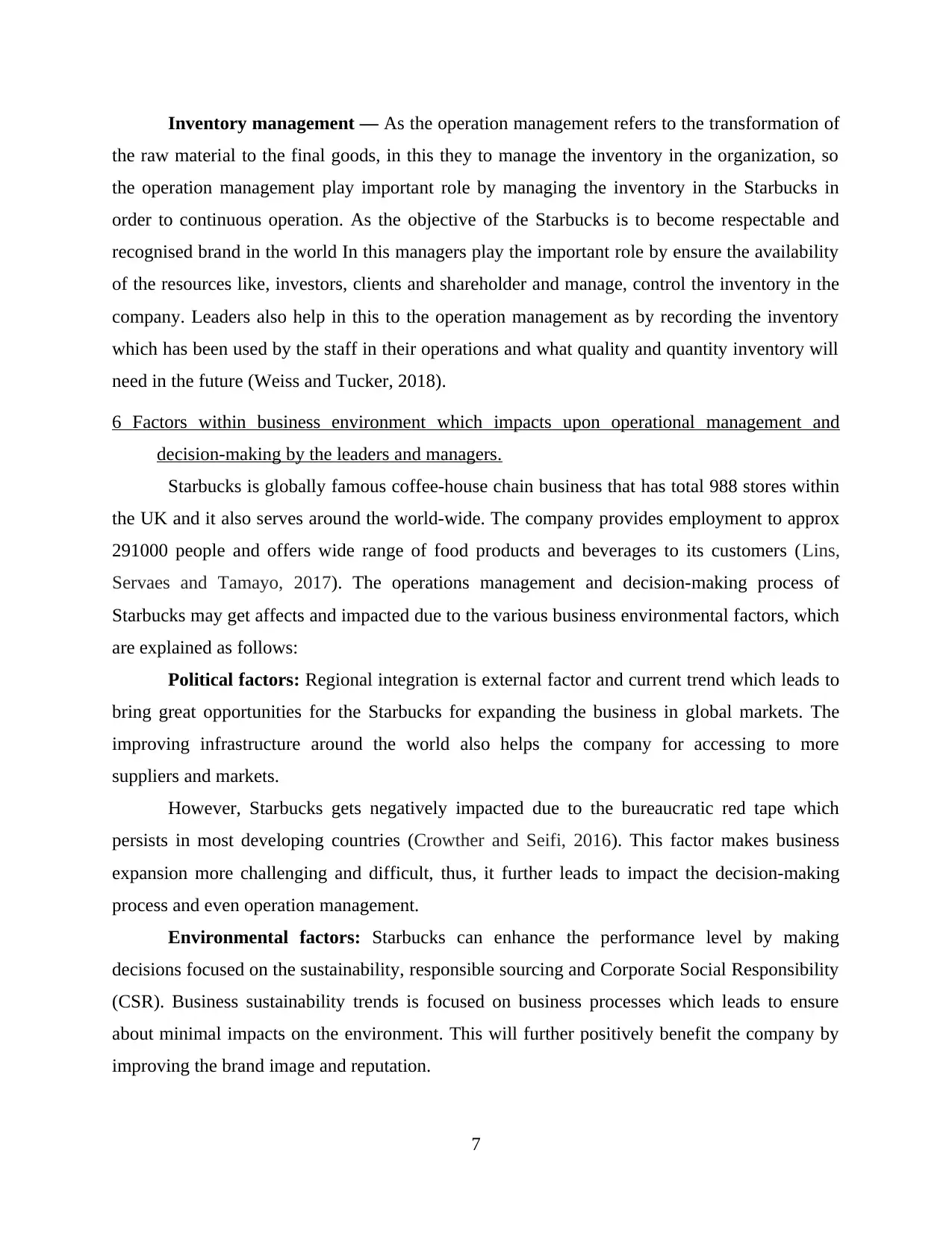
Inventory management — As the operation management refers to the transformation of
the raw material to the final goods, in this they to manage the inventory in the organization, so
the operation management play important role by managing the inventory in the Starbucks in
order to continuous operation. As the objective of the Starbucks is to become respectable and
recognised brand in the world In this managers play the important role by ensure the availability
of the resources like, investors, clients and shareholder and manage, control the inventory in the
company. Leaders also help in this to the operation management as by recording the inventory
which has been used by the staff in their operations and what quality and quantity inventory will
need in the future (Weiss and Tucker, 2018).
6 Factors within business environment which impacts upon operational management and
decision-making by the leaders and managers.
Starbucks is globally famous coffee-house chain business that has total 988 stores within
the UK and it also serves around the world-wide. The company provides employment to approx
291000 people and offers wide range of food products and beverages to its customers (Lins,
Servaes and Tamayo, 2017). The operations management and decision-making process of
Starbucks may get affects and impacted due to the various business environmental factors, which
are explained as follows:
Political factors: Regional integration is external factor and current trend which leads to
bring great opportunities for the Starbucks for expanding the business in global markets. The
improving infrastructure around the world also helps the company for accessing to more
suppliers and markets.
However, Starbucks gets negatively impacted due to the bureaucratic red tape which
persists in most developing countries (Crowther and Seifi, 2016). This factor makes business
expansion more challenging and difficult, thus, it further leads to impact the decision-making
process and even operation management.
Environmental factors: Starbucks can enhance the performance level by making
decisions focused on the sustainability, responsible sourcing and Corporate Social Responsibility
(CSR). Business sustainability trends is focused on business processes which leads to ensure
about minimal impacts on the environment. This will further positively benefit the company by
improving the brand image and reputation.
7
the raw material to the final goods, in this they to manage the inventory in the organization, so
the operation management play important role by managing the inventory in the Starbucks in
order to continuous operation. As the objective of the Starbucks is to become respectable and
recognised brand in the world In this managers play the important role by ensure the availability
of the resources like, investors, clients and shareholder and manage, control the inventory in the
company. Leaders also help in this to the operation management as by recording the inventory
which has been used by the staff in their operations and what quality and quantity inventory will
need in the future (Weiss and Tucker, 2018).
6 Factors within business environment which impacts upon operational management and
decision-making by the leaders and managers.
Starbucks is globally famous coffee-house chain business that has total 988 stores within
the UK and it also serves around the world-wide. The company provides employment to approx
291000 people and offers wide range of food products and beverages to its customers (Lins,
Servaes and Tamayo, 2017). The operations management and decision-making process of
Starbucks may get affects and impacted due to the various business environmental factors, which
are explained as follows:
Political factors: Regional integration is external factor and current trend which leads to
bring great opportunities for the Starbucks for expanding the business in global markets. The
improving infrastructure around the world also helps the company for accessing to more
suppliers and markets.
However, Starbucks gets negatively impacted due to the bureaucratic red tape which
persists in most developing countries (Crowther and Seifi, 2016). This factor makes business
expansion more challenging and difficult, thus, it further leads to impact the decision-making
process and even operation management.
Environmental factors: Starbucks can enhance the performance level by making
decisions focused on the sustainability, responsible sourcing and Corporate Social Responsibility
(CSR). Business sustainability trends is focused on business processes which leads to ensure
about minimal impacts on the environment. This will further positively benefit the company by
improving the brand image and reputation.
7
⊘ This is a preview!⊘
Do you want full access?
Subscribe today to unlock all pages.

Trusted by 1+ million students worldwide
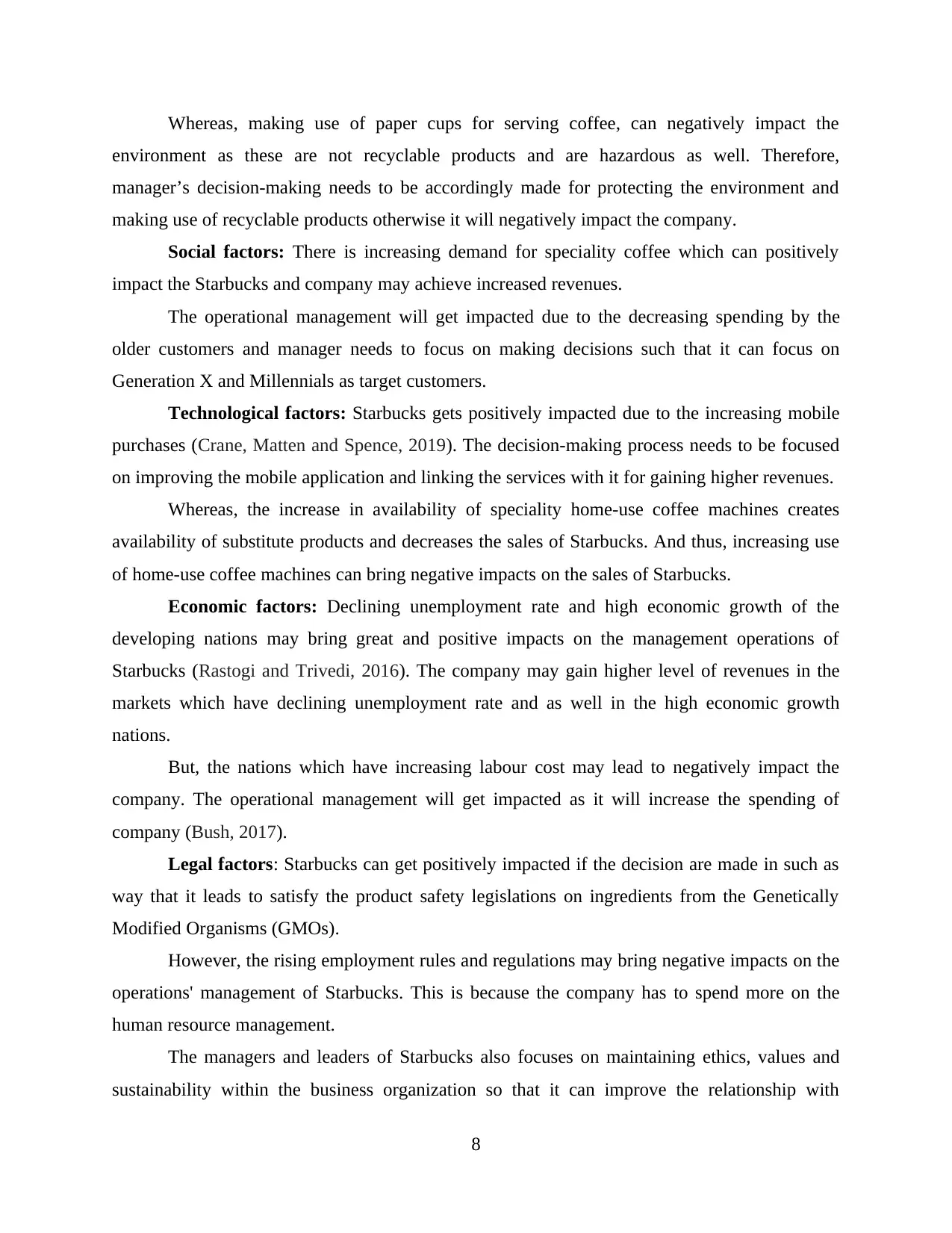
Whereas, making use of paper cups for serving coffee, can negatively impact the
environment as these are not recyclable products and are hazardous as well. Therefore,
manager’s decision-making needs to be accordingly made for protecting the environment and
making use of recyclable products otherwise it will negatively impact the company.
Social factors: There is increasing demand for speciality coffee which can positively
impact the Starbucks and company may achieve increased revenues.
The operational management will get impacted due to the decreasing spending by the
older customers and manager needs to focus on making decisions such that it can focus on
Generation X and Millennials as target customers.
Technological factors: Starbucks gets positively impacted due to the increasing mobile
purchases (Crane, Matten and Spence, 2019). The decision-making process needs to be focused
on improving the mobile application and linking the services with it for gaining higher revenues.
Whereas, the increase in availability of speciality home-use coffee machines creates
availability of substitute products and decreases the sales of Starbucks. And thus, increasing use
of home-use coffee machines can bring negative impacts on the sales of Starbucks.
Economic factors: Declining unemployment rate and high economic growth of the
developing nations may bring great and positive impacts on the management operations of
Starbucks (Rastogi and Trivedi, 2016). The company may gain higher level of revenues in the
markets which have declining unemployment rate and as well in the high economic growth
nations.
But, the nations which have increasing labour cost may lead to negatively impact the
company. The operational management will get impacted as it will increase the spending of
company (Bush, 2017).
Legal factors: Starbucks can get positively impacted if the decision are made in such as
way that it leads to satisfy the product safety legislations on ingredients from the Genetically
Modified Organisms (GMOs).
However, the rising employment rules and regulations may bring negative impacts on the
operations' management of Starbucks. This is because the company has to spend more on the
human resource management.
The managers and leaders of Starbucks also focuses on maintaining ethics, values and
sustainability within the business organization so that it can improve the relationship with
8
environment as these are not recyclable products and are hazardous as well. Therefore,
manager’s decision-making needs to be accordingly made for protecting the environment and
making use of recyclable products otherwise it will negatively impact the company.
Social factors: There is increasing demand for speciality coffee which can positively
impact the Starbucks and company may achieve increased revenues.
The operational management will get impacted due to the decreasing spending by the
older customers and manager needs to focus on making decisions such that it can focus on
Generation X and Millennials as target customers.
Technological factors: Starbucks gets positively impacted due to the increasing mobile
purchases (Crane, Matten and Spence, 2019). The decision-making process needs to be focused
on improving the mobile application and linking the services with it for gaining higher revenues.
Whereas, the increase in availability of speciality home-use coffee machines creates
availability of substitute products and decreases the sales of Starbucks. And thus, increasing use
of home-use coffee machines can bring negative impacts on the sales of Starbucks.
Economic factors: Declining unemployment rate and high economic growth of the
developing nations may bring great and positive impacts on the management operations of
Starbucks (Rastogi and Trivedi, 2016). The company may gain higher level of revenues in the
markets which have declining unemployment rate and as well in the high economic growth
nations.
But, the nations which have increasing labour cost may lead to negatively impact the
company. The operational management will get impacted as it will increase the spending of
company (Bush, 2017).
Legal factors: Starbucks can get positively impacted if the decision are made in such as
way that it leads to satisfy the product safety legislations on ingredients from the Genetically
Modified Organisms (GMOs).
However, the rising employment rules and regulations may bring negative impacts on the
operations' management of Starbucks. This is because the company has to spend more on the
human resource management.
The managers and leaders of Starbucks also focuses on maintaining ethics, values and
sustainability within the business organization so that it can improve the relationship with
8
Paraphrase This Document
Need a fresh take? Get an instant paraphrase of this document with our AI Paraphraser
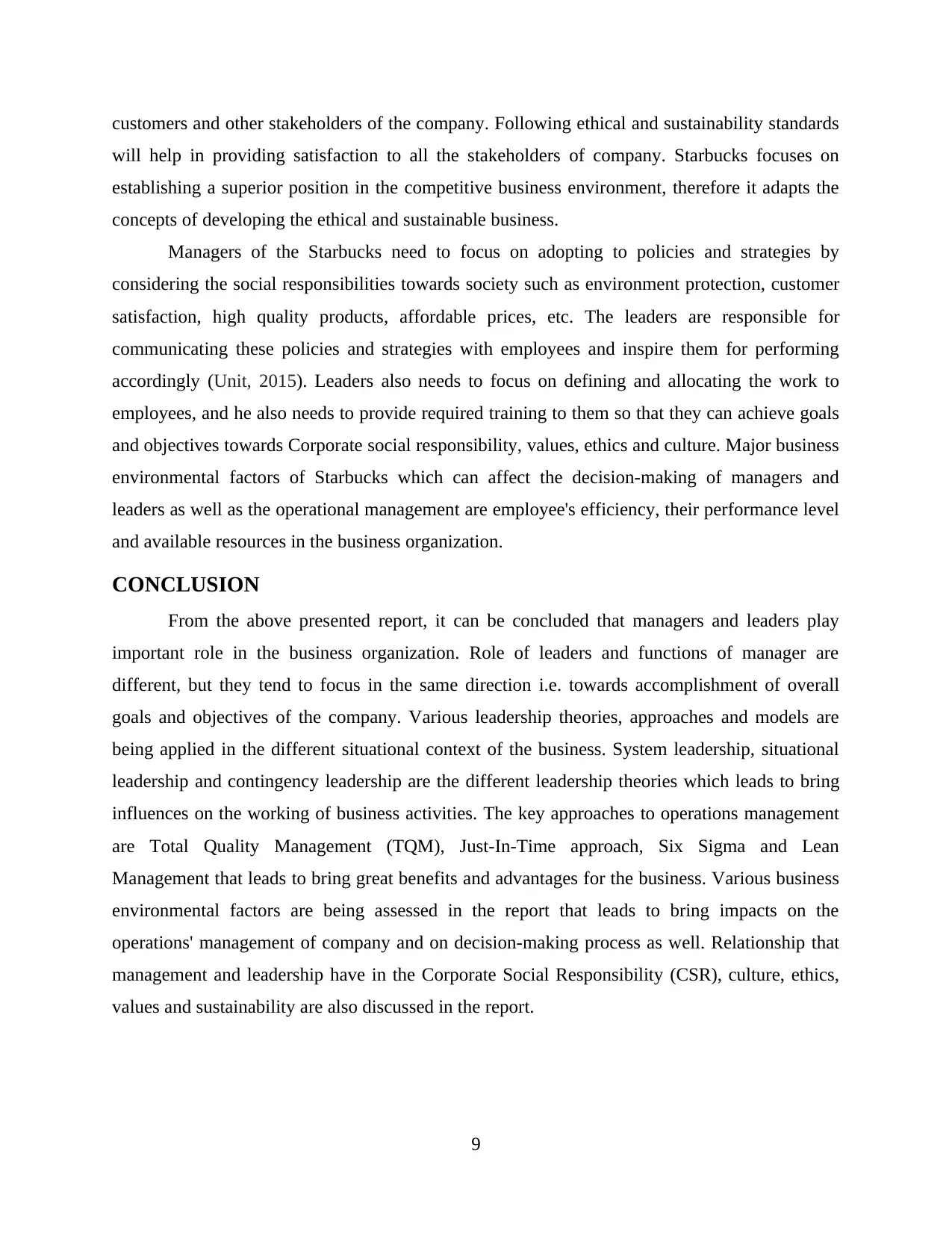
customers and other stakeholders of the company. Following ethical and sustainability standards
will help in providing satisfaction to all the stakeholders of company. Starbucks focuses on
establishing a superior position in the competitive business environment, therefore it adapts the
concepts of developing the ethical and sustainable business.
Managers of the Starbucks need to focus on adopting to policies and strategies by
considering the social responsibilities towards society such as environment protection, customer
satisfaction, high quality products, affordable prices, etc. The leaders are responsible for
communicating these policies and strategies with employees and inspire them for performing
accordingly (Unit, 2015). Leaders also needs to focus on defining and allocating the work to
employees, and he also needs to provide required training to them so that they can achieve goals
and objectives towards Corporate social responsibility, values, ethics and culture. Major business
environmental factors of Starbucks which can affect the decision-making of managers and
leaders as well as the operational management are employee's efficiency, their performance level
and available resources in the business organization.
CONCLUSION
From the above presented report, it can be concluded that managers and leaders play
important role in the business organization. Role of leaders and functions of manager are
different, but they tend to focus in the same direction i.e. towards accomplishment of overall
goals and objectives of the company. Various leadership theories, approaches and models are
being applied in the different situational context of the business. System leadership, situational
leadership and contingency leadership are the different leadership theories which leads to bring
influences on the working of business activities. The key approaches to operations management
are Total Quality Management (TQM), Just-In-Time approach, Six Sigma and Lean
Management that leads to bring great benefits and advantages for the business. Various business
environmental factors are being assessed in the report that leads to bring impacts on the
operations' management of company and on decision-making process as well. Relationship that
management and leadership have in the Corporate Social Responsibility (CSR), culture, ethics,
values and sustainability are also discussed in the report.
9
will help in providing satisfaction to all the stakeholders of company. Starbucks focuses on
establishing a superior position in the competitive business environment, therefore it adapts the
concepts of developing the ethical and sustainable business.
Managers of the Starbucks need to focus on adopting to policies and strategies by
considering the social responsibilities towards society such as environment protection, customer
satisfaction, high quality products, affordable prices, etc. The leaders are responsible for
communicating these policies and strategies with employees and inspire them for performing
accordingly (Unit, 2015). Leaders also needs to focus on defining and allocating the work to
employees, and he also needs to provide required training to them so that they can achieve goals
and objectives towards Corporate social responsibility, values, ethics and culture. Major business
environmental factors of Starbucks which can affect the decision-making of managers and
leaders as well as the operational management are employee's efficiency, their performance level
and available resources in the business organization.
CONCLUSION
From the above presented report, it can be concluded that managers and leaders play
important role in the business organization. Role of leaders and functions of manager are
different, but they tend to focus in the same direction i.e. towards accomplishment of overall
goals and objectives of the company. Various leadership theories, approaches and models are
being applied in the different situational context of the business. System leadership, situational
leadership and contingency leadership are the different leadership theories which leads to bring
influences on the working of business activities. The key approaches to operations management
are Total Quality Management (TQM), Just-In-Time approach, Six Sigma and Lean
Management that leads to bring great benefits and advantages for the business. Various business
environmental factors are being assessed in the report that leads to bring impacts on the
operations' management of company and on decision-making process as well. Relationship that
management and leadership have in the Corporate Social Responsibility (CSR), culture, ethics,
values and sustainability are also discussed in the report.
9
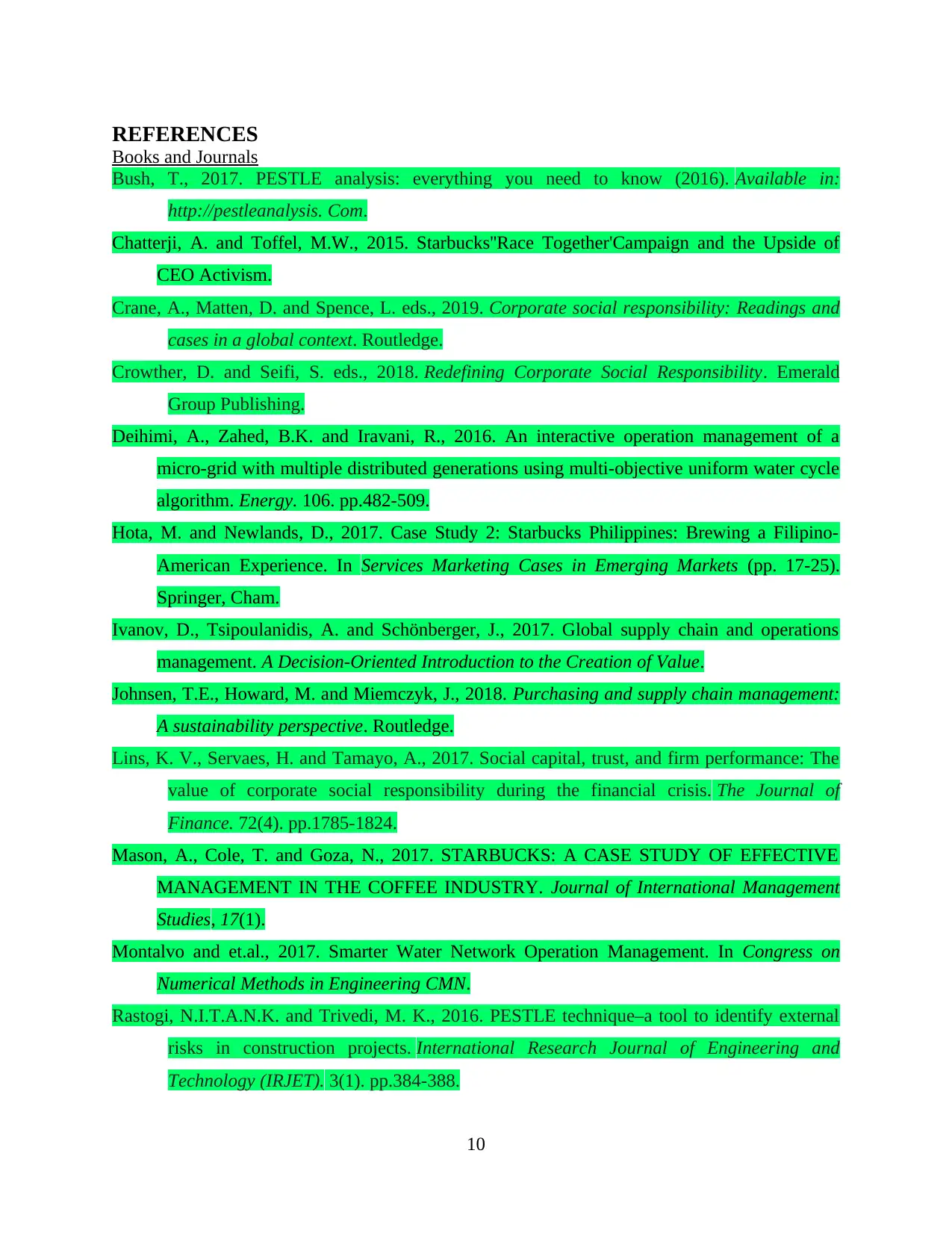
REFERENCES
Books and Journals
Bush, T., 2017. PESTLE analysis: everything you need to know (2016). Available in:
http://pestleanalysis. Com.
Chatterji, A. and Toffel, M.W., 2015. Starbucks''Race Together'Campaign and the Upside of
CEO Activism.
Crane, A., Matten, D. and Spence, L. eds., 2019. Corporate social responsibility: Readings and
cases in a global context. Routledge.
Crowther, D. and Seifi, S. eds., 2018. Redefining Corporate Social Responsibility. Emerald
Group Publishing.
Deihimi, A., Zahed, B.K. and Iravani, R., 2016. An interactive operation management of a
micro-grid with multiple distributed generations using multi-objective uniform water cycle
algorithm. Energy. 106. pp.482-509.
Hota, M. and Newlands, D., 2017. Case Study 2: Starbucks Philippines: Brewing a Filipino-
American Experience. In Services Marketing Cases in Emerging Markets (pp. 17-25).
Springer, Cham.
Ivanov, D., Tsipoulanidis, A. and Schönberger, J., 2017. Global supply chain and operations
management. A Decision-Oriented Introduction to the Creation of Value.
Johnsen, T.E., Howard, M. and Miemczyk, J., 2018. Purchasing and supply chain management:
A sustainability perspective. Routledge.
Lins, K. V., Servaes, H. and Tamayo, A., 2017. Social capital, trust, and firm performance: The
value of corporate social responsibility during the financial crisis. The Journal of
Finance. 72(4). pp.1785-1824.
Mason, A., Cole, T. and Goza, N., 2017. STARBUCKS: A CASE STUDY OF EFFECTIVE
MANAGEMENT IN THE COFFEE INDUSTRY. Journal of International Management
Studies, 17(1).
Montalvo and et.al., 2017. Smarter Water Network Operation Management. In Congress on
Numerical Methods in Engineering CMN.
Rastogi, N.I.T.A.N.K. and Trivedi, M. K., 2016. PESTLE technique–a tool to identify external
risks in construction projects. International Research Journal of Engineering and
Technology (IRJET). 3(1). pp.384-388.
10
Books and Journals
Bush, T., 2017. PESTLE analysis: everything you need to know (2016). Available in:
http://pestleanalysis. Com.
Chatterji, A. and Toffel, M.W., 2015. Starbucks''Race Together'Campaign and the Upside of
CEO Activism.
Crane, A., Matten, D. and Spence, L. eds., 2019. Corporate social responsibility: Readings and
cases in a global context. Routledge.
Crowther, D. and Seifi, S. eds., 2018. Redefining Corporate Social Responsibility. Emerald
Group Publishing.
Deihimi, A., Zahed, B.K. and Iravani, R., 2016. An interactive operation management of a
micro-grid with multiple distributed generations using multi-objective uniform water cycle
algorithm. Energy. 106. pp.482-509.
Hota, M. and Newlands, D., 2017. Case Study 2: Starbucks Philippines: Brewing a Filipino-
American Experience. In Services Marketing Cases in Emerging Markets (pp. 17-25).
Springer, Cham.
Ivanov, D., Tsipoulanidis, A. and Schönberger, J., 2017. Global supply chain and operations
management. A Decision-Oriented Introduction to the Creation of Value.
Johnsen, T.E., Howard, M. and Miemczyk, J., 2018. Purchasing and supply chain management:
A sustainability perspective. Routledge.
Lins, K. V., Servaes, H. and Tamayo, A., 2017. Social capital, trust, and firm performance: The
value of corporate social responsibility during the financial crisis. The Journal of
Finance. 72(4). pp.1785-1824.
Mason, A., Cole, T. and Goza, N., 2017. STARBUCKS: A CASE STUDY OF EFFECTIVE
MANAGEMENT IN THE COFFEE INDUSTRY. Journal of International Management
Studies, 17(1).
Montalvo and et.al., 2017. Smarter Water Network Operation Management. In Congress on
Numerical Methods in Engineering CMN.
Rastogi, N.I.T.A.N.K. and Trivedi, M. K., 2016. PESTLE technique–a tool to identify external
risks in construction projects. International Research Journal of Engineering and
Technology (IRJET). 3(1). pp.384-388.
10
⊘ This is a preview!⊘
Do you want full access?
Subscribe today to unlock all pages.

Trusted by 1+ million students worldwide
1 out of 13
Related Documents
Your All-in-One AI-Powered Toolkit for Academic Success.
+13062052269
info@desklib.com
Available 24*7 on WhatsApp / Email
![[object Object]](/_next/static/media/star-bottom.7253800d.svg)
Unlock your academic potential
Copyright © 2020–2025 A2Z Services. All Rights Reserved. Developed and managed by ZUCOL.





